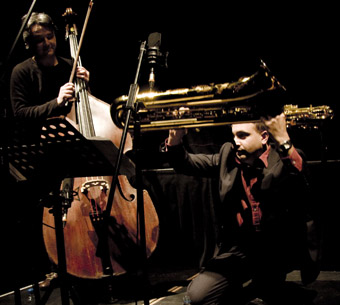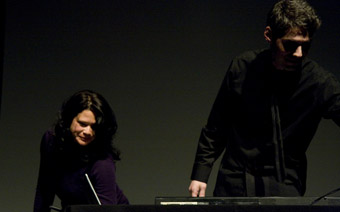the art of sonic curation
chris reid: liquid architecture 10, melbourne

Mark Cauvin, Adam Simmons performing Syd Clayton’s “Yehudi”
photo Louise Cooper
Mark Cauvin, Adam Simmons performing Syd Clayton’s “Yehudi”
A DECADE IS A LONG TIME IN THE WORLD OF EXPERIMENTAL MUSIC AND SOUND, AND THE STAYING POWER OF THE ANNUAL LIQUID ARCHITECTURE FESTIVAL IS A TRIBUTE TO THE ORGANISERS, ARTISTS AND AUDIENCES WHO ENTHUSIASTICALLY SUPPORT IT. AROUND AUSTRALIA, THE ANNUAL LA SERIES OF CONCERTS, FORUMS AND WORKSHOPS SHOWCASE THIS FIELD AND ALSO CONTRIBUTE TO ITS DEVELOPMENT. IN MELBOURNE, LIQUID ARCHITECTURE CELEBRATED ITS 10TH SEASON WITH AN EXCELLENT PROGRAM OF NEW AND RECENT WORK BY LOCAL AND INTERNATIONAL ARTISTS, AND THE PRESENTATION OF SOME LEGENDARY PIECES, NOTABLY EDGARD VARÈSE’S POÈME ÉLECTRONIQUE.
friday july 10
The emphasis in the Friday night concert was on listening attentively in a darkened space, and it opened with the enchanting and gentle work of Hamburg-based Asmus Tietchens. Since he began in the mid-1960s Tietchens has become a senior figure in European sound art, working outside any specific genre and often collaborating with other artists. His piece begins almost inaudibly, simple lines drawing your attention, and soon you notice additional voicing bringing complexity and depth as you enter a relaxed state of awareness. The music seems spontaneous and fluid, and you forget how it is made and just absorb it. This is perhaps the hallmark of good sound art, indeed of any interesting sound. While technological change, such as the development of computers, has affected the process of making sound, in the best works musicality is retained.
A memorable performance by the established local duo of Anthea Caddy (cello) and Thembi Sodell (sampler) followed. Contrasting strongly with Tietchens’ subtle and understated ambience, Caddy and Sodell’s intense and expressionistic work is characterised by huge dynamics, strong textures and dramatic pauses. Theirs is a unique sound, blending acoustic and sampled elements and underpinned by strong live performance, adding a freshness that is sometimes absent from the calculated presentation of pre-programmed work.
Jason Kahn’s work appears to involve manipulating feedback to produce a dense and intense body of sound. His apparatus includes a sensitive microphone placed close to the skin of a bass drum mounted on its side, and a radio whose untuned static is fed into a synthesiser with the miked sound. Kahn sits in the middle of the auditorium within touching distance of the audience, and holds a steel plate or a small cymbal just above the drum skin, subtly changing the sound by moving the object slightly. Sitting one seat away, I was one of the few who could hear a little of the unmediated sound direct from these objects. This created a fascinating effect as the sound through the PA built up. The sound evolves only slightly and gradually during the performance, so you concentrate on subtle variations; Kahn’s poised minimalism was distinctly different from the complex works that preceded it.
Tietchens reappeared with Thomas Köner as the duo Kontakt de Jünglinge, whose name pays homage to Stockhausen, and whose music is again gentle and subtle, developing in complexity as it unfolds. Their work has a maturity born of decades of development and thought. Afterwards, LA Artistic Director Nat Bates aptly described their piece as work of “glacial delicacy and restraint.” The final work of the evening was a performance by Berlin trio Perlonex—electric guitar with effects pedals, percussion and an electronically mediated turntable plied with all manner of objects. Their carefully prepared piece began quietly and gathered in intensity, with the acoustic elements combining with multiple layers of morphed sound, again emphasising live performance.
saturday july 11
Whereas the program for the first night focused on aural experience, the second concert showcased the use of sound to support, or contradict, visual experience, and also looked back to the beginnings of sound art and experimental multimedia. First we were treated to a rendition of the late Melbourne sound artist Syd Clayton’s composition Yehudi (1968). As the audience filed into the auditorium, two people were seated at a small table near the stage, chatting. The audience waited and waited and eventually the two performers—Mark Cauvin (double bass) and Adam Simmons (bass saxophone)—picked up their instruments. The performance unfolded as a mixture of mime and unconventional playing, with nonsensical physical gestures, hoots and grunts and included a tea break in which the performers discussed the piece, boiled a kettle and asked audience members for a cigarette. This is comic theatre that comments seriously on the limitations of conventional musical performance.

Kristi Monfries, David Shea; LA10 Melbourne
photo Louise Cooper
Kristi Monfries, David Shea; LA10 Melbourne
Another work with an historical thread followed—Kristi Monfries and David Shea’s video-sound work, the Art of Sampled Memory, that looked back at the work of Canadian experimental film-maker Arthur Lipsett. Lipsett edited the off-cuts of others’ films—mainly fragments of newsreels and documentaries—into collage works that critiqued contemporary society. Monfries and Shea re-edited Lipsett’s work and added their own sound to pay homage to his concept. Lipsett typically added sound that was irrelevant to the imagery to upset the relationship between the two, satirising the story. Monfries and Shea’s second work, Liquid Architects, commissioned by the festival for its 10th year, was a collage of videos of LA performances from previous years, showing visually enhanced fragments of performance with a contrasting sound overlay. In both works, Shea controlled the sound live, sitting centre-stage, positioning the artist as an active and visible element of the product. This was absorbing work.
Next was Thomas Köner’s moving, eloquent and very beautiful video and sound work La Barca. Köner, who performed in LA3 in 2002, has produced soundtracks for old silent films, and this work had the feel of decaying silent-film stock. The video slowly panned a deserted cityscape, shown in grey tones, positioning the audience as remote observers on a train moving inexorably through a post-apocalyptic world. Köner’s soundtrack is suitably dreamy and desolate, incorporating sampled voices and instruments. The evening concluded with a completely different audio-visual work, Plump (Marc Rogerson, Dave Brown, Philip Samartzis) ensemble’s performance involving a huge metal framework fitted with contact mikes and incorporating wires that could be bowed and plucked, set up amongst a series of sculptural forms illuminated from within and also connected to the mixer. The performer used an array of familiar objects to play this extended and highly tactile instrument.
sunday july 12
At the Melbourne Planetarium, the program included two engaging works by graduates of the RMIT University sound program, Que Nguyen and Lizzie Pogson, a delightful work by French pioneer of Musique Concrète and sometime LA associate Bernard Parmegiani, and Edgard Varèse’s Poème Électronique (1958). The afternoon concluded with Robin Fox’s very visual Photosynthesis (2004), created by feeding an audio signal into a cathode ray oscilloscope. Poème Électronique was a landmark work, developed for presentation in the Philips pavilion at the Brussels World’s Fair, combining synthesised and recorded sound with projected imagery in a purpose-built space designed by Xenakis and Le Corbusier to explore the possible relationships between sound, vision and architectural space. RMIT University senior lecturer Lawrence Harvey introduced this realisation of the work, outlining the background to the original project, its philosophical intent, and an overview of the history of sound art.
Liquid Architecture has grown from a student union event at RMIT University into a national festival that showcases the best national and international sound art (see Gail Priest’s interview with Nat Bates, RT91). The audience includes listeners at all levels of sophistication, and, importantly, artists and others professionally involved with the field. Paradoxically, presenting LA as a festival locates it within the mainstream, though sound art is energised by its experimental, critical and therefore marginal nature. So far, it has successfully operated on both fronts, complementing the range of contemporary concerts available while maintaining a critical distance. The internet now also provides a forum for dialogue and presentation, one with an almost infinite and thus unnavigable capacity. However the structured format of Liquid Architecture focuses programming and ensures vitally important curatorial direction. It is to be hoped that the festival continues to grow and develop.
Liquid Architecture 10, artistic director Nat Bates, Arts House, North Melbourne Town Hall, July 10, 11; Melbourne Planetarium, July 12
RealTime issue #92 Aug-Sept 2009 pg. 49






